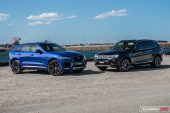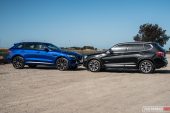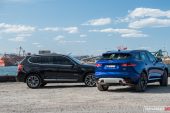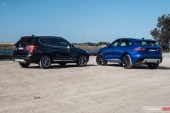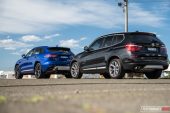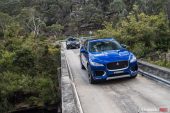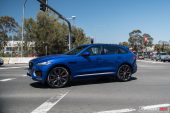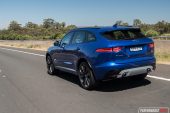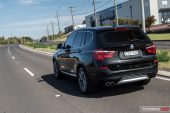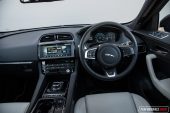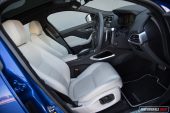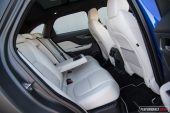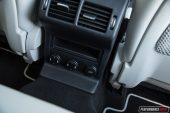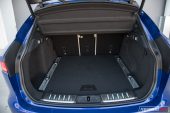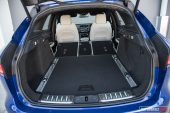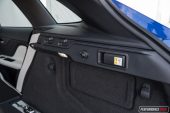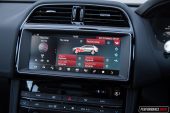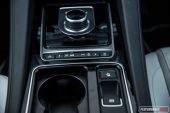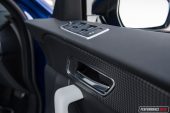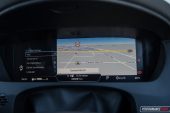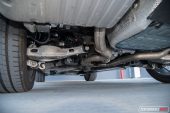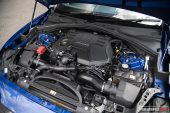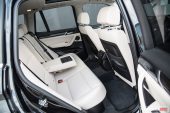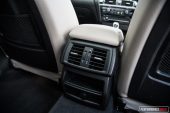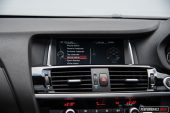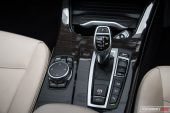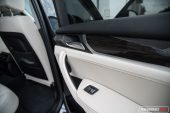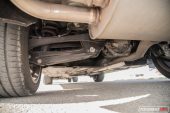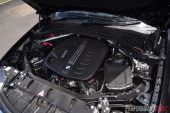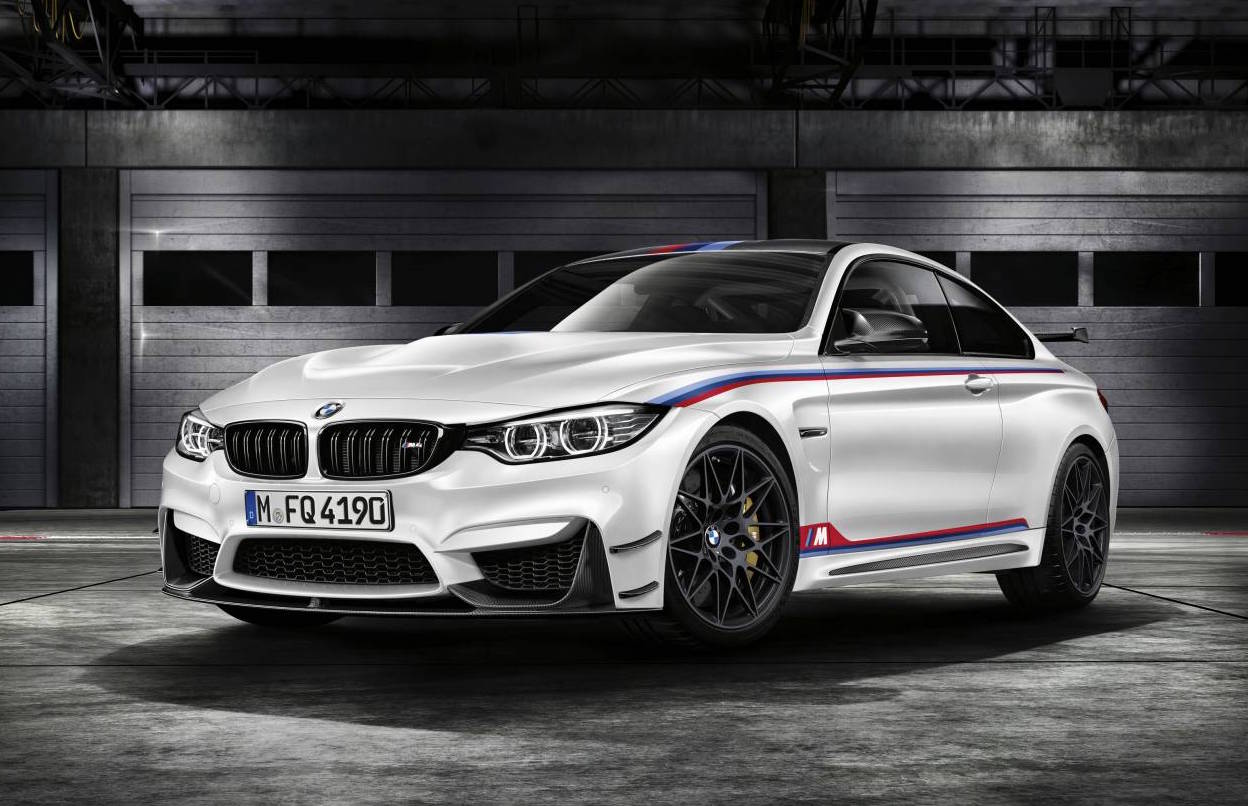| SPECS | PACKAGE | DRIVE | VERDICT |
So it’s an easy win for the new Jaguar F-PACE on the design front when compared with BMW’s ageing and rather uninteresting X3 design. But how does the newcomer from England shape up against one of the veterans of the premium SUV market, we wonder.
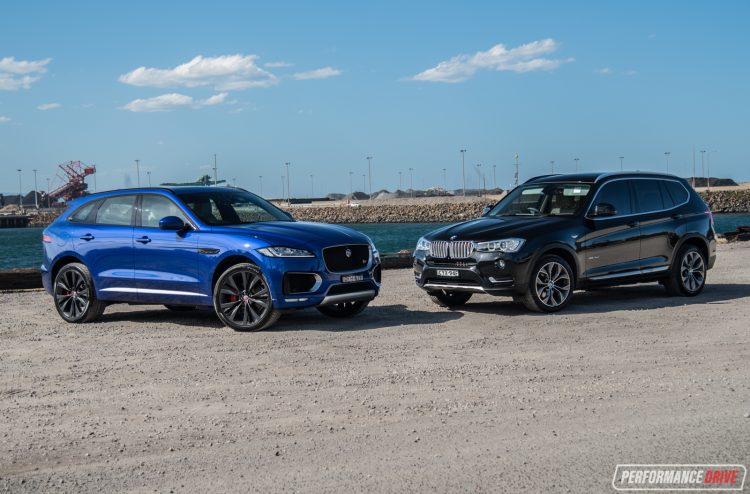
The BMW X3 in its current form has been around since 2014, and before the minor facelift it has actually been around since 2011. However, the ol’ X3 does possess some interesting benchmarks for the segment. It’s able to do this thanks to being the oldest and perhaps wisest nameplate, arguably pioneering the luxury mid-size SUV segment back in 2003. Does time to evolve win over cutting-edge design and British pomp and circumstance?
Specifically, here we have the Jaguar F-PACE S with the 30d 3.0-litre twin-turbo-diesel V6 producing 221kW and an insane 700Nm. This is paired to a ZF eight-speed auto (8HP70). What we should have said is, this is the top-of-the-range diesel model of the new F-PACE range.
From BMW is the X3 xDrive30d. This is also the top-of-the-range X3 (in Australia), and the most powerful X3 on offer (in Australia). It uses a 3.0-litre turbo-diesel straight six engine producing 190kW and 560Nm, matching up to a similar ZF 8HP eight-speed automatic. This engine is seen in many other BMW models, such as the lower-end X5. But in the X3 it does have a weight advantage. Or, more accurately, a lack of weight… advantage.
Initially we had booked in the R-Sport trim level for the Jag but instead we received the top ‘S’ trim, and as a bonus it’s one of the “First Edition” special editions. Although it’s not strictly an even comparison, the foundations are lineball; 30d top-spec versus 30d top-spec, both competing in the same “Medium SUV above $80,000” segment, according to the Australian Federal Chamber of Automotive Industries.

2016 Jaguar F-PACE 30d vs BMW X3 xDrive30d – THE SPECS
| 2016 Jaguar F-PACE 30d | BMW X3 xDrive30d | |
|---|---|---|
| Engine | 3.0-litre twin-turbo V6 | 3.0-litre turbo inline six |
| Output | 221kW@4000rpm / 700Nm@2000rpm | 190kW@4000rpm / 560Nm@1500-3000rpm |
| Transmission | Eight-speed automatic | Eight-speed automatic |
| Drive type | All-wheel drive, torque vectoring | All-wheel drive |
| Wheels | F & R: 20×8.5, 255/50 (22in as tested) | F: 19×8.5, 245/45 R: 19×9.5, 275/40 |
| ANCAP | Not tested | Five stars (scored 34.58 out of 37) |
| Tare weight | 1884kg | 1772kg |
| Power-to-weight | 8.52:1 (kg:kW) | 9.32:1 (kg:kW) |
| Official fuel economy | 6.0L/100km | 6.1L/100km |
| Economy during test | 7.8L/100km | 7.5L/100km |
| Fuel capacity/type | 66L/Diesel | 67L/Diesel |
| Power efficiency | 36.83kW:L/100km | 31.14kW:L/100km |
| 0-60km/h | 3.46 seconds* | 2.40 seconds* |
| 0-100km/h | 7.03 seconds* | 5.81 seconds* |
| 60-110km/h | – | – |
| 1/8 mile | 9.90 seconds at 122.1km/h* | 8.96 seconds at 126.2km/h* |
| 1/4 mile | 15.21 seconds at 151.6km/h* | 14.05 seconds at 153.8km/h* |
| Max acceleration | – | – |
| 100-0km/h braking | 2.88 seconds at 36.05 metres* | 2.93 seconds at 36.89 metres* |
| Max deceleration | – | – |
| Decibel at idle | 48* | 49* |
| Peak decibel at 60-100km/h | 84* | 80* |
| Priced from | $99,895 | $79,055 |
* Figures as tested by PerformanceDrive on the day. Factory claims may be different
2016 Jaguar F-PACE 30d vs BMW X3 xDrive30d – THE PACKAGE
To kick off this part let’s get the prices out of the way so we know what we’re dealing with. The X3 30d starts from $79,055, after some recent price drops as the model gets nearer to its inevitable expiration. Aside from the fact Aussies receive unsolicited astern penetration when it comes to luxury cars and their taxes, we think this is not bad value for a top-line German vehicle.
Likewise, the new Jag F-PACE 30d won’t exactly melt your cheque book, so long as you know this end of the market and choose your options wisely. If you go for the base model Prestige the 30d kicks off from $84,590. The First Edition is ridiculously overpriced though, from $117,210. But you needn’t worry as these special editions are probably all sold by now. Without the First Edition status the 30d in S form starts from $99,940. It is a lot more expensive than the BMW here but, as mentioned, it’s not a precise match in terms of equipment levels; the S comes with 20-inch wheels, for example, against the Bimmer’s 19s. (All prices exclude on-road costs.)
So even though the X3 is a lot more affordable in this specific comparison, we’ll hold off on awarding a winner in this department until after we’ve investigated more about the package and standard features.
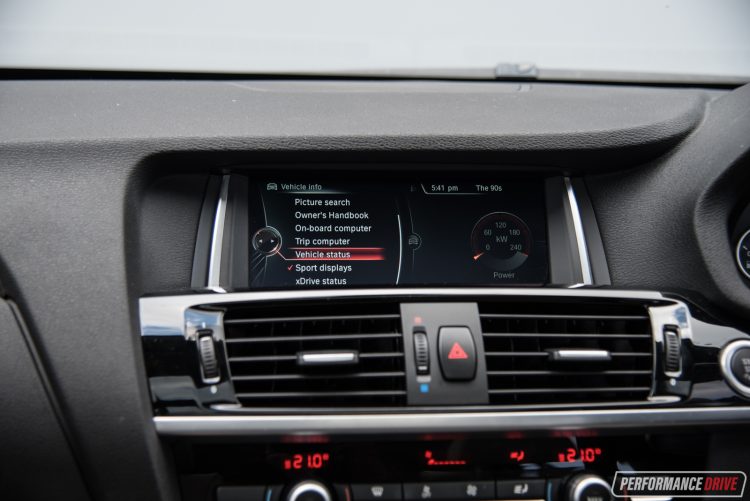
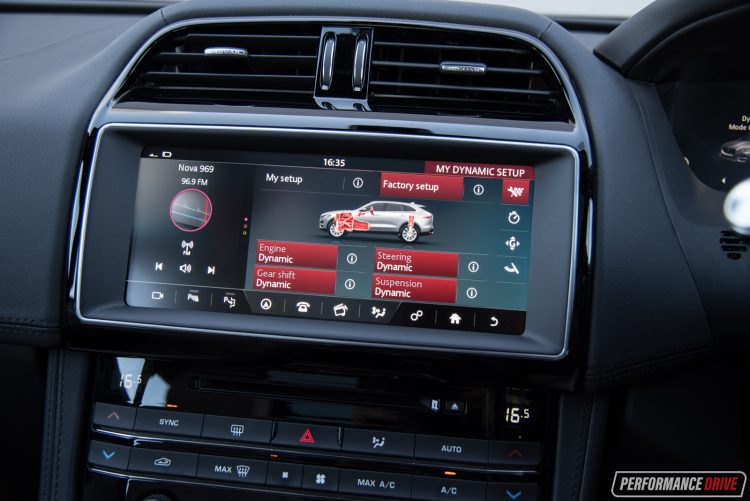
The X3 (pictured at top, above) comes with a pretty advanced iDrive on-board computer and wide-screen interface, even by today’s standards. The graphics are nice and clear, and functionality is, in our opinion, still leading the industry by example after being on the market for over five years now (yes, we know you’ve copied it, Mazda, with your MZD). You can view your live engine outputs, the complete driver’s manual with picture searching (not that anyone fixes their own car these days), and there’s full connectivity with internet capability via phone pairing (optional $200 for separate/vehicle SIM card). There’s also phone message readouts, a nice clear reversing camera and bird’s eye view, and parking sensors all around as standard.
Where the BMW is falling short is with apps. Everybody loves a good (or bad) app these days. BMW doesn’t offer a touch-screen experience either, whereas in the Jaguar you can swipe, prod and pinch your way around the screen and menus. The standard F-PACE S comes with apps and complete phone connectivity, but you will have to fork out an extra $750 for its InControl Apps. An additional $2550 will also get you HDMI support and an in-built hard drive to store media files. The BMW doesn’t offer these. Both offer advanced features such as optional head-up display ($2510 in Jag, $2000 in BMW), digital TV tuning ($2100 in Jag, $2250 in BMW), and a panoramic glass roof ($3000 for fixed in Jag [$4200 for sliding], $3000 in BMW [sliding only]).
The BMW also falls behind with safety technologies and advanced driving assistance features. Forward collision mitigation with automatic (low speed) braking is standard on the F-PACE S whereas in the X3 it’s a $900 option. However, a front camera is standard on the X3 while in the Jaguar it’s part of the surround-view option of $2050. Overall safety is rated at five stars by ANCAP in the X3, scoring 34.58 out of 37, while the F-PACE hasn’t been tested – probably because it’s too beautiful to damage?
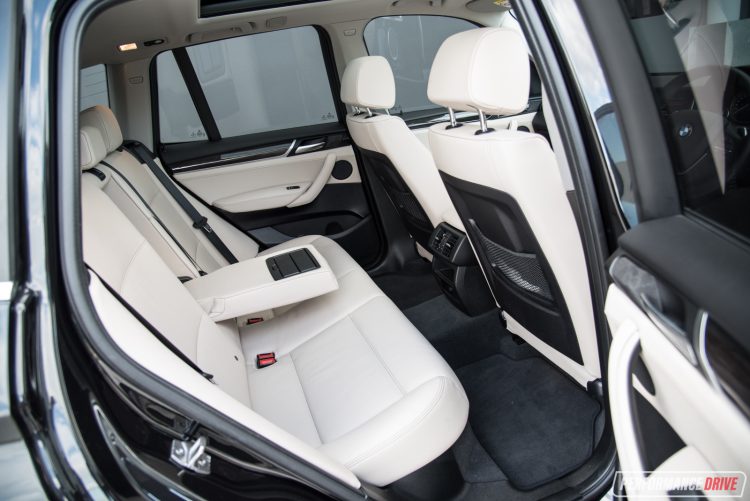
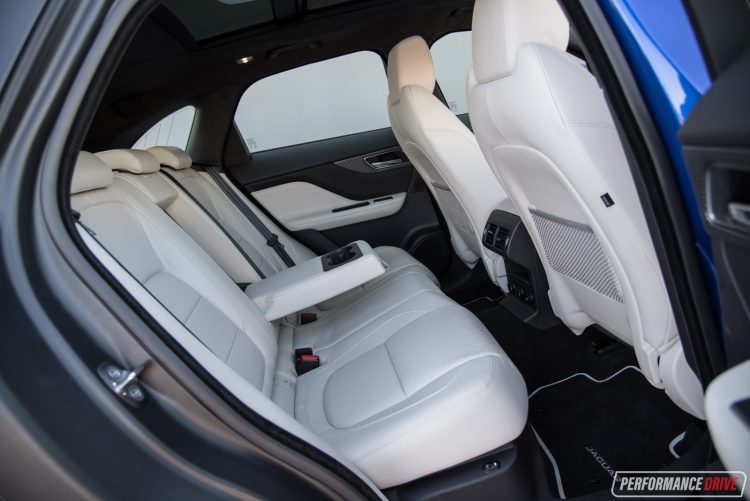
As for passenger space, these two vehicles will surprise you. On the outside the Jaguar looks (and is) larger. But it uses much thicker doors and swollen panels to create that gorgeous look. Inside, it’s the Jaguar that actually feels more cramped. It is a sportier layout though, with shorter windows providing a narrower, enclosed view, much like a sports car. In the X3 it’s a more traditional SUV or even ‘4WD’ layout, with taller windows and a higher ceiling.
Cabin ambience is theatrical and stylish in the Jaguar, with exquisite details and materials. In contrast, the X3 is pretty boring and clean-cut. The X3 still uses conventional square or rectangular plastic buttons, whereas in the Jag you get suave metal controls, softer-touch buttons and surfaces, and the oh-so-cool windowed climate controls and rising gear shifter. Boot space goes to the Jaguar, with 650L/1740L against the X3’s 550L/1600L, with the X3 offering a lower load height. Both feature a 12V plug in the boot and second row.
If user-friendliness and passenger space is high on your priority checklist then the X3 will be more attractive to you. The taller ceiling lends itself better with larger passengers, and it’s also easier to get in and out of with unobtrusive pillars, good visibility, and perfect hip-height seating so you can just slide straight across and in.
Given the Jaguar is clearly more advanced and more attractively designed inside, especially when optioned with the fully digital instrument cluster (as tested), and the fact that it comes with superior safety features as standard, the F-PACE wins on packaging in the majority of areas. But we must commend the X3 for its more affordable sticker price and slightly more practical cabin.
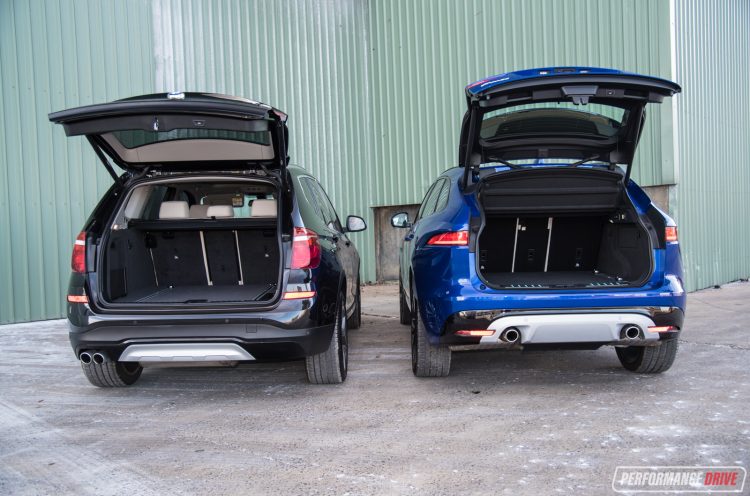
2016 Jaguar F-PACE 30d vs BMW X3 xDrive30d – THE DRIVE
These two vehicles are categorised as SUVs. So that’s Sports Utility Vehicle, which promises sportiness with a level of utility. Just how much utility really depends on how much you love the wheels and the bodywork, as both feature road-oriented tyres with intolerant low profile tyre walls. Jaguar claims a ground clearance of 213mm while BMW is miles behind at 212mm. Neither of these measurements bode well for off-roading, but with all-wheel drive in both, they can be useful machines in the snow and on very slippery surfaces such as camping ground grass and dirt roads. The X3 comes with hill-descent control and that’s about it, while the Jag adds some off-road driving modes stemming from Land Rover. Needless to say, we’d expect the F-PACE to venture further into the bush than the X3 in a proper all-terrain test, if fitted with more appropriate wheels and tyres.
Although the F-PACE engine really shifts and shoves you in the back, especially with low- to mid-range pull, the BMW simply walks all over the Jaguar in terms of acceleration and engine performance. Perhaps more importantly too, the Jaguar doesn’t ‘feel’ as quick, partly down to its 1884kg tare weight compared with the X3’s 1772kg mass. But to put some black and white maths into the picture we pulled out the Racelogic VBox to validate. The X3 recorded a best 0-100km/h of 5.81 seconds, bettering our previous time of 5.88 (back when we used to round up to one decimal place), while the Jaguar, as hard as we tried (including using all drive modes and manual mode), could only manage a best of 7.03 seconds.
We had some comments on our POV comparison video on YouTube, with viewers telling us to flick the Jag into manual mode to start off in first gear as the transmission usually takes off in second. We tried this, it cut only 0.2 seconds mainly because it needs to shift almost immediately into second. The Jaguar’s final drive ratio is shorter than the X3’s, at 3.23:1 compared with the X3’s taller 2.81:1 ratio, while the 8HP transmission uses identical ratios. Officially, Jaguar claims a time of 6.2 seconds and BMW claims 5.9. All of that peak torque in the Jaguar is accessible at 2000rpm, while in the X3, although a smaller figure, it’s spread from 1500-3000rpm. Power peaks at 4000rpm in both engines.
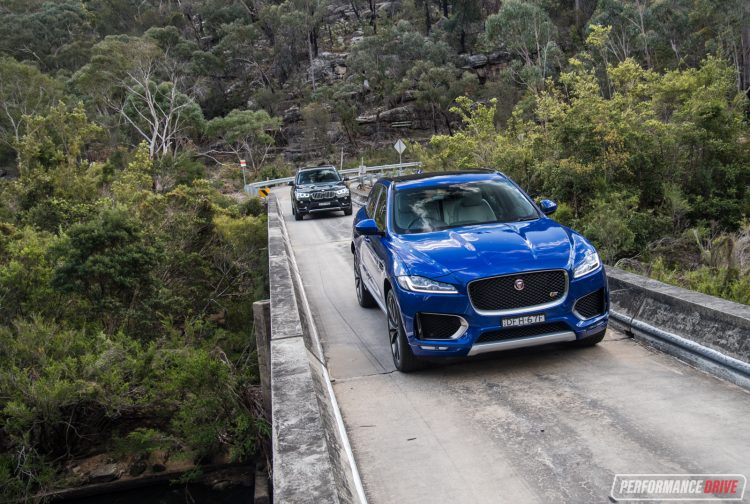
We had a little jousting session with the two vehicles along our favourite mountain road and found the Jaguar to approach its limits much sooner than the X3. We know the X3 is old but boy does it drive well. The steering, while not as nice as the optional M Sport steering, is a delight and very communicative, and the previous-gen 3 Series wagon chassis underneath with coil-over struts front and rear is pre-prepared to cope with hard cornering. It feels like it wants to make turns. Like it actually enjoys it. The staggered wheel and tyres sizes with 275s on the back also help. There is some minor understeer to contend with when you’re at the upper end of the hold-on-for-dear-life scale, and we suspect this has something to do with the heavy inline six diesel sitting on the nose. We also suspect the standard front strut tower braces (as featured on the Jag too) might be out of sync with this specific engine/suspension/wheel package. Again, the M Sport suspension does help boost overall balance and ability if this is important to you.
We should probably say at this point that the F-PACE is certainly no clumsy pig when it comes to handling. In fact, it steers brilliantly, in true Jaguar fashion. With the delightful steering wheel right at your chest providing a perfect driving position, this is an SUV you want to take on a big drive. Every day. Visibility is compromised a touch, as mentioned, but it’s a bit like blinkers on a race horse, focusing your attention where it should be. Understeer isn’t really a problem in the F-PACE 30d. Instead, the body does feel heavy and out of its comfort zone when really pushed, and there is a minor delay in communication between body movements and reactions. This is only recognisable at the upper limits though, which is not where this vehicle was designed to spend a majority of its time. In all other areas, for example, taking a leisure drive along the coast, the F-PACE is bliss. Open the sunroof blind. Sink into the comfy leather chairs. And just enjoy that surging 700Nm. As we found out in our 35t F-PACE S test, the 22-inch alloy wheels aren’t the best match if you’re planning really spirited driving. But they do look stunning.

In terms of highway cruising and comfort, the Jaguar feels more planted and solid/heavy in a straight line, and it seems to plough through the air offering greater high-speed stability. Interestingly, the Jaguar isn’t the most aerodynamic of the two, despite the sleeker appearance. In fact, they both possess a drag coefficient of 0.34.
Aerodynamic efficiency isn’t that important in Australia, with our 42-year-old 110km/h maximum speed limits (in most states). Ride comfort is probably going to be more important in this market. And in this S trim, the Jaguar presents the firmest ride of the two – not helped by those unforgiving thinly strapped tyres. We have driven the X3 with the M Sport pack, which could be seen as the precise equivalent to this F-PACE S, and it is just as stiff. But here and now, the X3 has a smoother ride.
Lastly, if you’re considering a diesel, chances are you’re interested in fuel economy and a long driving range. We experienced around 7.5L/100km in the X3 on test and about 7.8L/100km in the Jaguar. Of course it all depends on how you drive. A fairer and more consistent set of numbers to look at are the official average figures. These are measured in the same conditions and in the same way, industry wide. The 30d F-PACE is rated at 6.0L/100km while the X3 30d is rated at 6.1L/100km. In the Jag you get a 66L tank that results in a theoretical driving range of 1100km (using the official average consumption), compared with the X3’s 67L tank and 1098km range. It doesn’t get much closer. We should award the Jaguar the winner in this specific area as its engine produces a lot more power and torque and it has to push around a heavier vehicle, yet its fuel economy is marginally better, on paper at least.

2016 Jaguar F-PACE 30d vs BMW X3 xDrive30d – THE VIDEO
2016 Jaguar F-PACE 30d vs BMW X3 xDrive30d – THE VERDICT
We like both of these vehicles very much. The BMW X3 really is a superb driver’s car, even though it’s an SUV. It feels noticeably lighter and nimbler in the bends and its engine feels – and is – more energetic and faster. The cabin is also more user-friendly, if a little behind in terms of technology and design. However, the new F-PACE is a beautiful machine. And undeniable beauty tends to go a lot further than modesty, even if the underlying character behind modesty is very skilled.
For only driving enthusiasts, you need the X3. But for everyone else, the F-PACE does present a more appealing overall package, especially considering what the majority of buyers are going to be asking of these cars. The fact that it’s Jaguar’s first-ever SUV also gives it an endearing quality. We do love the current X3 and eagerly look forward to the next model, but for now the keys to the Jag are just too damn irresistible.
